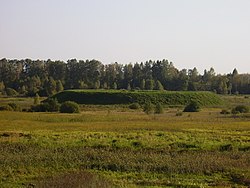Mstsibava
Mstsibava | |
|---|---|
Village | |
 Site of the original settlement | |
| Coordinates: 53°06′45″N 24°15′29″E / 53.11250°N 24.25806°E | |
| Country | Belarus |
| Region | Grodno Region |
| District | Vawkavysk District |
| Population (2013) | |
• Total | 500 |
| Time zone | UTC+3 (MSK) |
| Area code | +375 1512 |
Mstsibava or Mstibovo (Belarusian: Мсцібава, romanized: Mscibava; Russian: Мстибово; Polish: Mścibów; Yiddish: אמסטיבוב, romanized: Amstibov) is a village in Vawkavysk District, Grodno Region, Belarus. It is part of Hnyezna selsoviet.[1]
History

In the Grand Duchy of Lithuania
An early settlement [BE] existed in the area in the 12th-13th century under the Grand Duchy of Lithuania, where a wooden fort was built.[2] The village was also home to a palace, sometimes called the Schloss, which had been built by Jogaila as his summer home.[3] Although the first settlers were pagans (hence the name Mstibovo, named after a pagan deity), the village later became Christian, with a Catholic church built in 1512.[4][5]
17th century
During the Deluge, the village and its ancient fort were burnt down.
18th century
The fort was rebuilt in 1715, and in 1770, burnt down again.[2]
As part of the Russian Empire
In 1795, Mstibovo came under Russian rule with the Third Partition of Poland.[2]
19th century
During the French invasion of Russia in 1812, Napoleon's Grande Armée was welcomed in Mstibovo. Napoleon appointed a Jew as the village's mayor. Soon after however, the Russians retook the region.[6]
20th century
In the late nineteenth century, the village grew exponentially, and in 1914, numbered 1,137 residents.[7]
During World War I, fighting erupted in Mstibovo, first between the Russians and Germans, and later between the Russians and Polish, which resulted in the partial destruction of the village.[6]
As part of the Polish Republic
In 1921, Mstibovo came under Polish control.
Part of USSR
World War II
In 1939, during World War II, the region was taken by the Russians and incorporated into the Byelorussian Soviet Socialist Republic (BSSR), and in 1941, it was conquered by the Nazis.[2] During World War II, the town's rector, Mark Burak, was murdered along with 50 parishioners.[8] After the Soviet victory in 1945, Mstibovo was once more part of BSSR.
After the dissolution of the Soviet Union in 1991, the BSSR was renamed Republic of Belarus, under whose authority Mstibovo remains.
Jewish community
Mstibovo was home to an ancient Jewish community, dating back to the Middle Ages (evident from tombstones in the ancient Jewish cemetery). The community, approximately 80 families, lived in the center of the village, where its synagogue was situated.[6] Rabbis in the community's history include Rabbi Meir HaKohen (father of Rabbi Shabbatai HaKohen), Rabbi David HaLevi Segal, and Rabbi Isser Yehuda Unterman.[9]
During the Holocaust, in late June 1941, the village's Jews were transported to Vawkavysk and from there to Treblinka where they were gassed to death. Reportedly, there was one survivor who went back to Mstibovo after the war.[2]
Today
Mstibovo is currently under the governance of the Hniezna Selsoviet in the Vawkavysk District, Grodno Region, Belarus. The village is home to a school, a library, and a church. Valuable items from the nineteenth and twentieth centuries are stored in the church.[8]
As of 2013, it has 500 residents,[10] nearly twice as many than the 287 residents in 2007.
Notable residents
- Rabbi Shabbatai HaKohen, Halakhist, Talmudist, born in Mstibovo
- Rabbi Isser Yehuda Unterman, chief rabbi of Israel, served as Mstibovo's rabbi for six years
- Rabbi Yitzchak Bernstein, rosh kollel in Israel, born in Mstibovo
See also
References
- ^ Gaponenko, Irina Olegovna (2004). Назвы населеных пунктаў Рэспублікі Беларусь: Гродзенская вобласць. Minsk: Тэхналогія. p. 129. ISBN 985-458-098-9.
- ^ a b c d e "Time Line - The History of Mscibow vs Jewish and European History". kehilalinks.jewishgen.org. JewishGen. Retrieved 18 April 2021.
- ^ Golan, Yehudit (May 2016). The Night Is Not Dark. Mesorah Publications, Ltd. p. 54. ISBN 978-1-4226-1732-8.
Several centuries earlier, a massive stone fortress was built straddling the hill. The building, square, sealed and forbidding, was called "the Schloss by the Jewish residents, signifying a structure behind lock and bolt. A Polish king, His Majesty Yagelo, had erected his summer home high on a hilltop overlooking these pastoral surroundings.
- ^ "О католичестве и католиках: Мстибово (About Catholicism and Catholics: Mstibovo)". zen.yandex.ru (in Russian). Yandex Zen. Retrieved 18 April 2021.
- ^ "Website of Catholic Parish". catholic.by. Retrieved 14 April 2021.
- ^ a b c Golan, Yehudit (May 2016). The Night Is Not Dark. Mesorah Publications, Ltd. p. 56. ISBN 978-1-4226-1732-8.
- ^ "Volume V: Białystok Voivodeship". Index of Places in the Republic of Poland (Polish: Skorowidz miejscowości Rzeczypospolitej Polskiej). Warsaw: Statistics Poland. 1924.
- ^ a b Sw (local guide), Міхаіл Кліменка (local guide). "Kostel Svyatogo Ioanna Krestitelya". google.com. Google Maps. Retrieved 23 April 2021.
- ^ "Rabbis in Mscibow (Amstiveva) and from Mscibow". kehilalinks.jewishgen.org. JewishGen. Retrieved 18 April 2021.
- ^ Mstsibova in GeoNames.Org (cc-by); post updated 2013-07-11; database download in 2015-06-27

